Obwohl es Kunststoffe noch gar nicht so lange gibt, sind sie heute nicht mehr aus unserem Alltag wegzudenken. Kunststoffprodukte finden sich in nahezu allen Lebensbereichen. Ohne sie wären hygienisch abgepackte Lebensmittel, medizinische Bedarfsartikel sowie zahlreiche technische Komponenten für die Elektro-, Bau- und Automobilindustrie nicht möglich.
Wie Kunststoff die Welt eroberte
Die ersten Kunststoffe wurden um die Jahrhundertwende auf der Basis von natürlichen Materialien entwickelt. Sie imitierten Elfenbein und Seide und besetzten zunächst nur eine Marktnische. In dieser Zeit entstanden auch die ersten Betriebe in Österreich, die Knöpfe, Kämme und Modeartikel aus diesen Kunststoffen fertigten. 1911 folgte mit der Gründung der „Österreichische AG für Zelluloid Fabrikation" die Zelluloseproduktion in Form von Platten, Stäben und Rohren.
Der erste vollsynthetische Kunststoff wurde 1907 von Leo Hendrik Baekeland erfunden. In Anlehnung an seinen Namen nannte er seine Erfindung „Bakelit“. Die Kunstharzmasse ließ sich in Formen pressen und durch Wärme und Druck härten. Nach Auslaufen des Patents im Jahr 1927 breitete sich die Bakelit-Produktion auch in Österreich aus. Mitte der 30er Jahre gab es bereits mehr als dreißig Kunstharz-Pressereibetriebe mit rund 2.000 Mitarbeitern. Kurz darauf kamen auch die ersten Spritzgussmaschinen zum Einsatz.
Die Markteinführung von PVC markierte Ende der 30er einen weiteren Meilenstein in der Geschichte des Kunststoffs. Der Plastik-Boom begann aber erst nach dem Zweiten Weltkrieg in den 50er und 60er Jahren. PVC avancierte neben Polyethylen und Polypropylen zum wichtigsten Kunststoff für die Herstellung einer Vielzahl von Haushalts- und Industrieprodukten. Der Markt verzeichnete zweistellige Wachstumsraten. 1950 betrug in Österreich der Pro-Kopf-Verbrauch an verarbeiteten Kunststoffen lediglich 0,3 kg. 1970 belief er sich schon auf 37,6 kg, 1980 stieg er auf 98,8 kg und heute liegt er bei rund 150 kg (inklusive Harze für Lacke, Leime etc.).
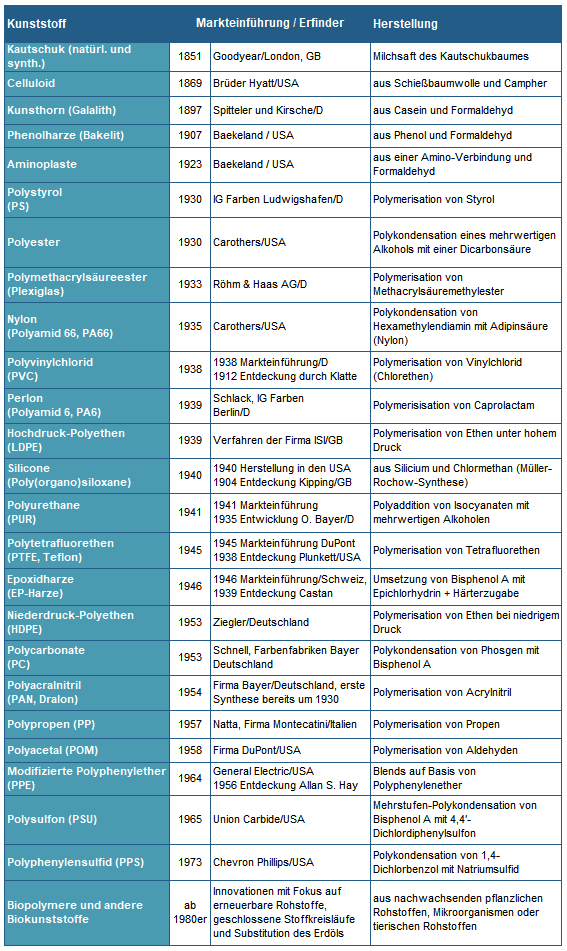
Was sind Kunststoffe eigentlich?
Kunststoffe sind künstlich hergestellte Makromoleküle (Polymere), die aus einer Vielzahl sich wiederholtender organischer Moleküle (Monomere) zusammensetzt sind. Bestehen Polymere aus nur einem Monomer spricht man von Homopolymer. Entstehen die Polymere aus mindestens zwei verschiedenen Arten von Monomeren erhält man Copolymere. Aufgrund ihres geringeren Schmelzpunktes sind Copolymere beständiger und biegefester als Polymere.

Die meisten Kunststoffe bestehen aus den Elementen Kohlenstoff (C), Wasserstoff (H) und Sauerstoff (O). Seltener sind auch Stickstoff (N), Schwefel (S), Chlor (Cl), Fluor (F) oder Silicium (Si) zu finden.
Polymere + Additive = Kunststoff
Kunststoffe zeichnen sich gegenüber anderen Materialien durch eine breite Palette an physikalischen Eigenschaften aus, die sie als Werkstoffe attraktiv machen:
- Leichtigkeit: Ihre Dichte ist nur ungefähr halb so gross wie die der Werkstoffe Glas, Porzellan oder Leichtmetall. Das macht sie zum effizienten Verpackungsmaterial und verringert als Werkstoff in Fahrzeugen den Treibstoff- und Energieverbrauch.
- Isolationsfähigkeit: Fast alle Kunststoffe sind Nichtleiter und isolieren gut gegen Elektrizität und Wärme. Eine 5 cm dicke Isolierschicht aus Kunststoffschaum reduziert beispielsweise die Heizkosten eines Einfamilienhauses auf nahezu die Hälfte.
- Formbarkeit: Sie lassen sich leicht und kostengünstig formen.
- Flexibilität: Sie können je nach Einsatzzweck „massgeschneidert“ gefertigt werden.
- Beständigkeit: Sie sind beständig gegen Wasser, viele auch gegen Säuren und Laugen, und sie oxidieren nicht.
Die meisten Kunststoffe enthalten zusätzlich zu den Polymeren sogenannte
Additive, um bestimmte Materialeigenschaften zu verbessern oder die Verarbeitung zu erleichtern. Demzufolge unterscheidet man Funktionszusatzstoffe (z.B. Weichmacher, Antistatika, Färbemittel) und Verarbeitungshilfsmittel (z.B. Gleitmittel, Stabilisatoren, Treibmittel).
Durch die vielfältigen Möglichkeiten Polymere und Additve compoundiert zu vermischen und zu verarbeiten, ergibt sich eine immense Bandbreite an Materialien bis hin zu Hochleistungskunststoffen. Insgesamt sind heute weit mehr als 200 Kunststoffarten bekannt.
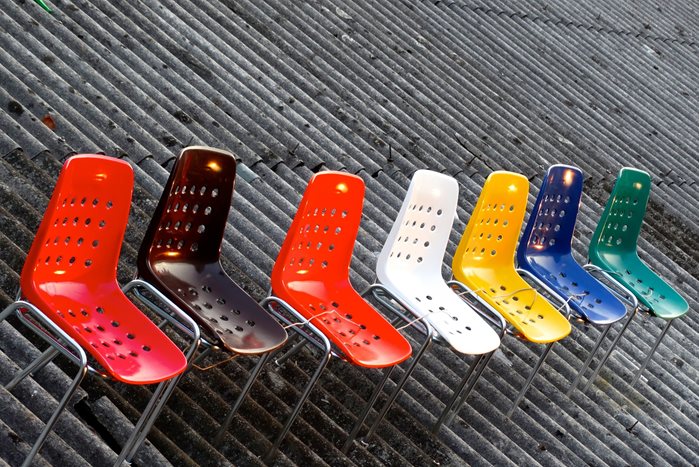
Synthetische Kunststoffe versus Biokunststoffe
Der überwiegende Anteil an Kunststoffen wird aus Erdöl durch chemische Synthese erzeugt. Neben synthetischen Kunststoffen gewinnen halbsynthetische, biologisch abbaubare Kunststoffe auf Basis pflanzlicher und tierischer Quellen sowie andere Formen von Biokunststoffen zunehmend an Bedeutung.
1. Synthetische Kunststoffe auf Basis von Erdöl
Bei der Herstellung von synthetischen Kunststoffen wird das Erdöl zunächst durch Destillation in flüssige und gasförmige Bestandteile sowie diverse Rückstände aufgetrennt. Dabei entsteht Rohbenzin (Naphta), welches durch das sogenannte Cracking-Verfahren in Ethylen, Propylen, Butylen und andere Kohlenwasserstoff-Verbindungen aufgespalten wird.
Anschließend erfolgt die Synthese, in der durch Hitze, Lösungen oder Druck aus den Monomeren netz- oder kettenförmige Polymere entstehen (Polyaddition, Polymerisation, Polykondensation, Copolymerisation). In der Bezeichnung des Kunststoffes spiegelt sich, welche Bestandteile für seine Herstellung verwendet wurden, z.B. Polyethylen oder Polypropylen.
2. Halbsynthetische und andere Biokunststoffe
Halbsynthetische Biokunststoffe (Biopolymere) werden durch chemische Modifikation eines natürlichen Polymers (Kautschuk zu Gummi,
Cellulose zu Celluloid) oder durch Polymerisation biologischer Moleküle (Milchsäure zu Polymilchsäure, Stärke zu thermoplastischer Stärke) erzeugt. Zu den wichtigsten Biokunststoffen gehören:
- Polyethylenfuranoat (PEF)
- Thermoplastische Stärke (TPS)
- Celluloseacetat (CA)
- Polylactide (PLA, nur in Blends)
- Polyhydroxybutyrat (PHB)
- Bio-Polyethylen (Bio-PE)
- Bio-Polypropylen (Bio-PP)
Nach gegenwärtigem Sprachgebrauch steht „bio“ sowohl für für „biobasiert“ als auch für „biologisch abbaubar“. Als Biokunststoffe werden daher auch biologisch abbaubare Kunststoffe aus fossilen Quellen bezeichnet, etwa abbaubare Polyester.
Ebenso zählen biobasierte, nicht abbaubare Kunststoffe zu Biokunststoffen. Dabei handelt es sich um naturfaserverstärkte Kunststoffe wie etwa Hanf- und Flachsfasern mit Polypropylen, Polyethylen, Polyethylenterephthalat oder Phenolharz sowie Holz-Kunststoff-Verbundwerkstoffe (Wood-PlasticsComposites; WPC).
Letztere sind thermoplastisch verarbeitbare Verbundwerkstoffe, z.B. aus Polyethylen oder Polypropylen mit bis zu 80 Prozent Holzmehl und Additiven. Die Produktionsmenge dieser Kunststoffe ist in Europa inzwischen allein in der Bau- und Möbelindustrie auf 12.000 Tonnen pro Jahr gewachsen. Die europäische Automobilindustrie setzt jährlich weitere 50.000 Tonnen ein.
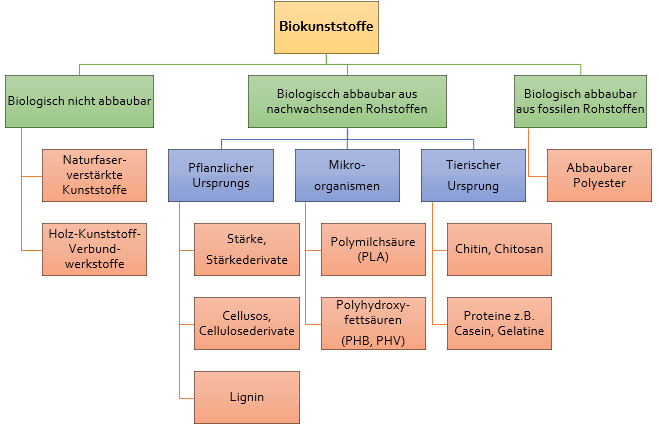
Vom „Duroplast-Bomber“ zu Hochleistungswerkstoffen
Die Art des Synthese-Verfahrens bestimmt, welche Charakteristika der Kunststoff aufweist. Je nach seinen physikochemischen Eigenschaften, wird der Kunststoff in eine von drei Kategorien eingeordnet (unabhängig von der Rohstoffquelle):
-
Thermoplaste sind Materialien, die beim Erhitzen weich und nach Absenken der Temperatur wieder hart werden. Sie können mehrmals eingeschmolzen und wieder verwendet werden. Dazu gehören z.B. Plexiglas (Brillengestelle), Polyester (Einwegflaschen), PVC (Rohre) oder Polyethylen (Tragetaschen).
- Elastomere sind Materialien, die sich sowohl bei Zug- wie auch bei Druckbelastung elastisch verformen und dann wieder ihre ursprüngliche Form zurückbilden, wenn die Krafteinwirkung endet. Aus Elastomeren werden Polyurethan (Bälle), Gummi (Gummibänder) oder Silikon (Backformen) hergestellt.
- Duroplaste sind Materialien, die auch unter Temperatureinfluss hart bleiben, sobald sie ihre Form angenommen haben. Duroplasten finden sich zum Beispiel als Bakelit in Pistolengriffen, als Aminoplaste in Haushaltsgeräten oder als Epoxidharze im Motor- und Segelflugsport. Auch das Kultauto der DDR, der Trabant, wurde aus diesem Kunststoff gefertigt und ging als „Duroplast-Bomber“ in die Geschichte ein.
Letztlich war der Duroplast-Bomber seiner Zeit weit voraus, auch wenn das damals kaum jemand erkannt hat. Denn gerade Formel 1-Rennautos oder Sportwagen der Luxusklasse und auch
normale Autos sind heute selbst Plastikbomber, wenn auch gefertigt aus hochwertigeren Kunststoffen.
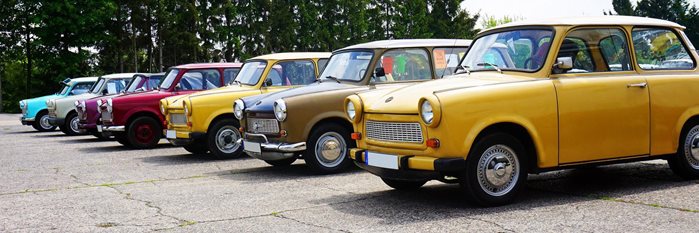
KMU prägen die österreichische Kunststoffindustrie
Die Kunststoffindustrie ist mit einem Anteil von 47,5 % ein wichtiger Bestandteil der österreichischen Chemieindustrie (35,7 % Kunststoffwaren und 11,8 % Kunststoffe in Primärformen).
Aufgrund des kleinen Inlandmarktes in Österreich setzen die meisten Unternehmen der Branche auf eine Exportstrategie. Rund zwei Drittel des Gesamtumsatzes werden im Export erzielt, mehr als 80 % der Kunststoffwaren werden dabei in andere europäische Länder exportiert.
Im Jahr 2020 lag die abgesetzte Produktion der Kunststofferzeuger und -verarbeiter bei rund 7,2 Mrd Euro. Neben Kunststoffrohstoffen und Kunststoffwaren werden auch Additive in Österreich hergestellt.
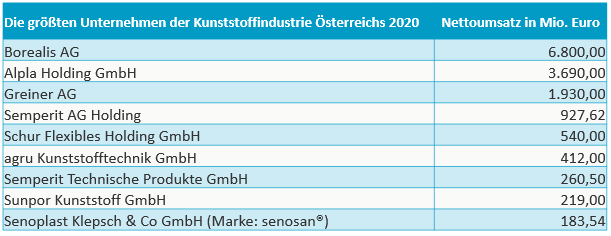
Kunststoffverarbeitung in Österreich
Die KMU-dominierte Kunststoffverarbeitung umfasst in Österreich etwa 570 Betriebe mit durchschnittlich 56 Mitarbeitern und 14 Millionen Euro Jahresumsatz. Nur 5 % der Unternehmen beschäftigen über 250 Mitarbeiter. Der größte Teil des Produktionswertes und mehr als 50 % der insgesamt 30.500 Arbeitsplätze finden sich in Nieder- und Oberösterreich.
Pro Jahr werden in Österreich 1,1, Mio t Polymere (Duroplaste und Thermoplaste) verarbeitet. Etwa 37 % des Branchenumsatzes entfallen auf Halbzeug wie Platten, Folien, Schläuche und Profile, 16 % auf Verpackungsmittel, 13 % auf Baubedarfsartikel sowie 34 % auf sonstige Kunststoffwaren (2019).
Die abgesetzte Produktion im Jahr 2020 betrug 5,4 Mrd. Euro. Die Exportquote beläuft sich auf durchschnittlich 33 %. Einige Betriebe sind fast zur Gänze auf den Exportmarkt ausgerichtet.
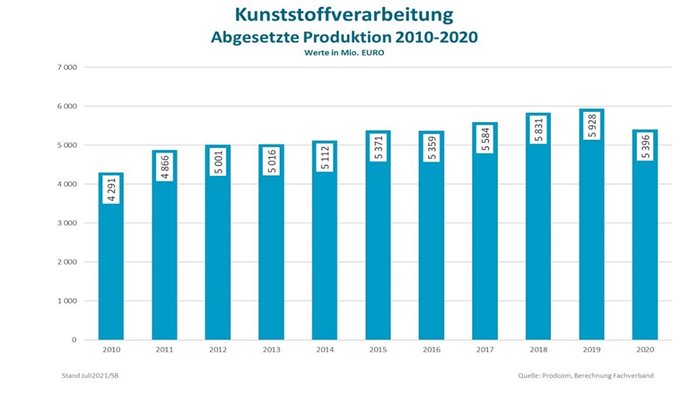
Kunststofferzeugung in Österreich
Den Kunststoffverarbeitern stehen auf der Beschaffungsseite 18 Rohkunststofferzeuger mit durchschnittlich 400 Millionen Euro Umsatz gegenüber. Der größte Kunststoffhersteller Österreichs und Nummer zwei in Europa ist die
Borealis AG. Das Unternehmen erzeugt in Schwechat rund 1 Mio. t Polyolefine. Im Jahr 2020 erreichte die Borealis im Geschäftssegment Polyolefine weltweit einen Umsatz von rund 4,57 Milliarden Euro.
Ein erheblicher Anteil der erzeugten Rohkunststoffe wird direkt in Unternehmen der Verbraucherindustrien verarbeitet. So stellt etwa die Lebensmittelindustrie selbst Verpackungen her, dasselbe gilt für die Produktion von Teilen für Elektrogeräte oder Kabel in der Elektroindustrie. Relevante Abnehmer sind auch die Kunstfaser- und die Schiindustrie.
Die abgesetzte Produktion der Kunststofferzeugung belief sich 2020 auf rund 1,8 Mrd Euro. Der überwiegende Anteil wurde exportiert. Das Produktportfolio umfasst die Standardkunststoffe Polyethylen (PE), Polypropylen (PP) und expandiertes Polystyrol (EPS), Harze für Lacke und Klebstoffe sowie andere Kunststoffe.
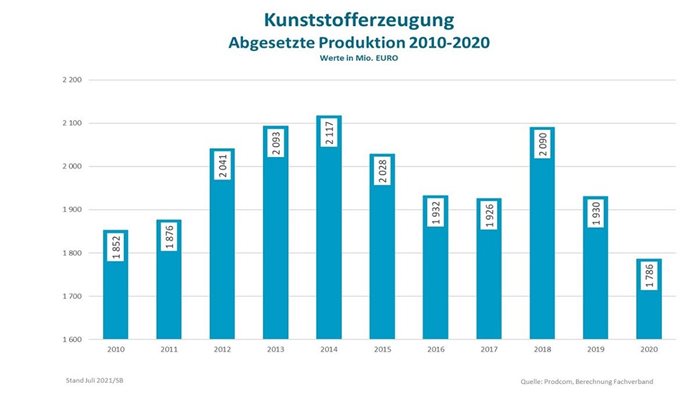
Außenhandel der Kunststoffverarbeitung in Österreich
Der Anteil der Kunststoffwaren an den österreichischen Exporten liegt seit Jahren bei etwa 3 % - und damit etwas über dem EU-Anteil von zuletzt 2,5 %. Exportüberschüsse ergeben sich vor allem in den Bereichen technische Kunststoffwaren und Kunststoffverpackungen.
2020 wurden Kunststoffwaren (aus Erzeugung und Handel) im Wert von ca. 4,2 Mrd. Euro exportiert. Der größte Handelspartner ist Deutschland mit mehr als einem Drittel aller Ausfuhren, gefolgt von Frankreich, Schweiz, Italien und Tschechien. Bei den Importen in Höhe von 3,9 Mrd. Euro rangiert Deutschland ebenfalls als wichtigster Partner an erster Stelle, gefolgt von Italien und der Schweiz.
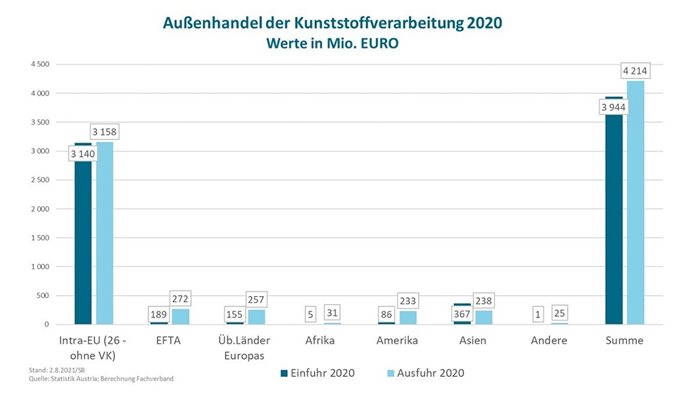
Aktuelle Situation der Kunststoffindustrie in Europa
Die Hauptabnehmer von Rohkunststoffen in Europa sind die Verpackungsindustrie (40 %), die Bauwirtschaft (20 %), die Kfz-Industrie (10 %) und Elektro- und Elektronikindustrie (6 %). Die Erholung der europäischen Abnehmerindustrien, wie der Automobilindustrie, aber auch die anhaltend hohe Nachfrage nach Kunststoffen in Primärformen außerhalb Europas wirkte sich 2021 positiv auf die Produktion aus.
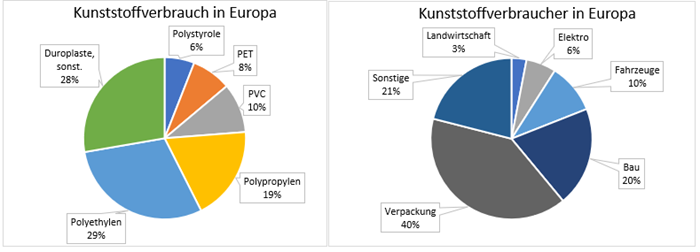
Quelle:
PlasticsEurope, UniCredit Research, Prozentangaben beziehen sich auf das Jahr 2018
Allerdings dämpfen nach wie vor externe Effekte wie Probleme in der globalen Lieferkette, Engpässe bei Vorprodukten und stark
steigende Energiepreise die Produktion. So stiegen etwa die Erzeugerpreise für Kunststoffe in Primärformen 2021 stark an. Hauptgrund waren die im Vergleich zu 2020 um 95 % höheren Preise für Naphtha in der EU. Auch sind die Energiepreise, die Transportkosten und Kosten für Additive gestiegen.
Als energieintensive Branche ist die Kunststoffindustrie von den hohen Energiepreisen besonders stark betroffen. Auch wenn es zu keiner Einschränkung der Energielieferungen aus Russland kommt, werden die Energiepreise voraussichtlich aufgrund der hohen Unsicherheiten und der
Auswirkungen der Sanktionen auf einem hohen Niveau bleiben.
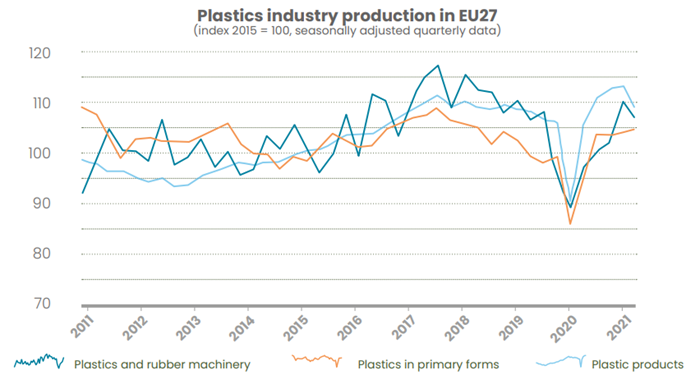
Quelle:
Plastics Europe, Plastics – the Facts 2021
Fazit: Kunststoffindustrie
Die Kunststoffindustrie ist eine Branche mit vielfältigen Möglichkeiten „Werkstoffe nach Maß“ in Großserie herzustellen. Nicht zuletzt liegen die Vorteile von Kunststoffprodukten in Bereichen wie Leichtbau, Lebensmittelhaltbarkeit, Wärmedämmung, Energieeffizienz, Funktionsintegration und vielem mehr. Mit der zunehmenden Verwendung nachhaltiger Kunststoffe und Forcierung der Kreislaufwirtschaft verringert sich auch der ökologische Fußabdruck von Kunststoffprodukten.
 www.donauchem.at
Weiterführende Links/Quellen:
Plastics Europe Quaterly Report Q4-2021
Bank Austria Branchenbericht Kunststoffverarbeitung 2020
Advantage Austria – Zahlen und Fakten Branche Chemie/Kunststoff
Plastics Europe, Plastics - the Facts 2021
AK Branchenreport, Kunststoffverarbeitendes Gewerbe 2021
www.donauchem.at
Weiterführende Links/Quellen:
Plastics Europe Quaterly Report Q4-2021
Bank Austria Branchenbericht Kunststoffverarbeitung 2020
Advantage Austria – Zahlen und Fakten Branche Chemie/Kunststoff
Plastics Europe, Plastics - the Facts 2021
AK Branchenreport, Kunststoffverarbeitendes Gewerbe 2021
Plastikmüll unerwünscht: Frachter verweigern Exporte (
orf.at Stand 19.04.2022)